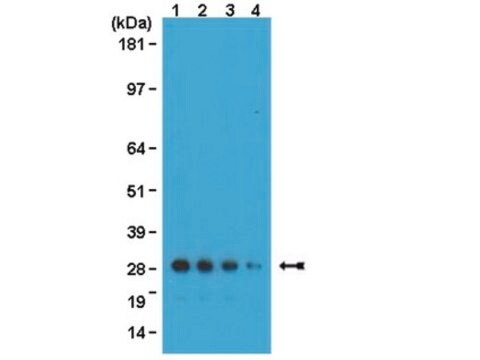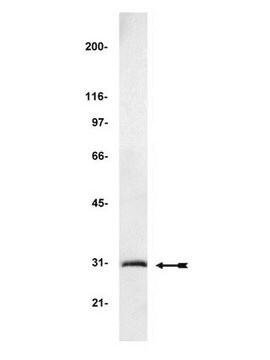MAB3580
Anti-Green Fluorescent Protein Antibody
Chemicon®, from mouse
Sinónimos:
GFP, eGFP
About This Item
Productos recomendados
origen biológico
mouse
Nivel de calidad
forma del anticuerpo
affinity purified immunoglobulin
tipo de anticuerpo
primary antibodies
clon
monoclonal
reactividad de especies (predicha por homología)
all
fabricante / nombre comercial
Chemicon®
técnicas
ELISA: suitable
immunocytochemistry: suitable
immunohistochemistry: suitable
western blot: suitable
isotipo
IgG1
Nº de acceso UniProt
modificación del objetivo postraduccional
unmodified
Descripción general
Especificidad
Inmunógeno
Aplicación
Immunocytochemistry: 1:500-1:1,000
Immunohistochemistry: 1:500-1:1,000 on paraformaldehyde fixed tissues with an overnight incubation using Nickel enhanced DAB for detection. Suggested permeabilization method is 0.5% Triton X-100. Recommended blocking buffer is PBS containing BSA and serum from the host of the secondary antibody. Recommended dilution buffer is PBS containing 1 mg/mL of BSA.
ELISA: 1:1,000-1:2,000 in a direct assay.
Optimal working dilutions must be determined by the end user.
Descripción de destino
Forma física
Otras notas
Información legal
¿No encuentra el producto adecuado?
Pruebe nuestro Herramienta de selección de productos.
Opcional
Código de clase de almacenamiento
12 - Non Combustible Liquids
Clase de riesgo para el agua (WGK)
WGK 2
Punto de inflamabilidad (°F)
Not applicable
Punto de inflamabilidad (°C)
Not applicable
Certificados de análisis (COA)
Busque Certificados de análisis (COA) introduciendo el número de lote del producto. Los números de lote se encuentran en la etiqueta del producto después de las palabras «Lot» o «Batch»
¿Ya tiene este producto?
Encuentre la documentación para los productos que ha comprado recientemente en la Biblioteca de documentos.
Los clientes también vieron
Nuestro equipo de científicos tiene experiencia en todas las áreas de investigación: Ciencias de la vida, Ciencia de los materiales, Síntesis química, Cromatografía, Analítica y muchas otras.
Póngase en contacto con el Servicio técnico










